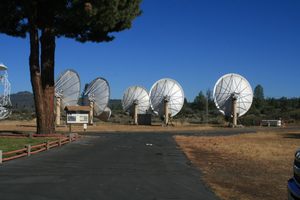Hat Creek Radio Observatory in Hat Creek, California
The Hat Creek Radio Observatory was founded in late 1950s by the Radio Astronomy Laboratory, part of the astronomy department at the University of California, Berkeley. An 85-foot antenna was installed in 1962, which led to the discovery of the first astrophysical maser in 1965. Alas, this dish collapsed in a windstorm in 1993. Millimeter-wave astronomy became a focus in the early 1970s, with the construction of a two-element interferometer. Further elements were later added, culminating in a total of 10 after the loss of the 85-foot dish. This array was called BIMA (Berkeley Illinois Maryland Association) and was relocated in 2005. Removal of BIMA made room for the Allen Telescope Array, the only instrument designed specifically for the purpose of SETI (the Search for Extraterrestrial Intelligence) research. It is named after the late Paul Allen, cofounder of Microsoft, who contributed some $30 million of seed money. The ATA currently consists of 42 antennas, with more planned as funding permits. It is both cheaper than a single big dish and more flexible, as its configuration can be changed. Linking lots of small dishes has become practical due to the decreasing costs of the high-performance electronics needed. ATA has a very broad range both spatially and in wavelengths covered (0.5 to 11.2 GHz). With its electronics it is also capable of "multitasking," carrying out conventional radio telescope observations simultaneously with SETI investigations, even on several stars at once, as at least one target star is usually in the field of view of the current investigation. Most recently, Hat Creek has become the site of one of three "outriggers" for CHIME, the Canadian Hydrogen Intensity Mapping Experiment. CHIME, whose main antenna is located at the Dominion Radio Astrophysical Observatory outside Penticton, British Columbia, has proved extraordinarily effective at detecting Fast Radio Bursts, exceedingly violent events at extreme distances whose origin is completely unknown at present, and whose location in the sky is very poorly determined. Simultaneous observations with "outrigger" antennas allow the locations of the FRBs to be narrowed down significantly. The University of California, Berkeley transferred control of the Hat Creek Radio Observatory to SRI International in 2012, and the SETI Institute now runs the facility on a day-to-day basis.


The Hat Creek Radio Observatory was founded in late 1950s by the Radio Astronomy Laboratory, part of the astronomy department at the University of California, Berkeley. An 85-foot antenna was installed in 1962, which led to the discovery of the first astrophysical maser in 1965. Alas, this dish collapsed in a windstorm in 1993.
Millimeter-wave astronomy became a focus in the early 1970s, with the construction of a two-element interferometer. Further elements were later added, culminating in a total of 10 after the loss of the 85-foot dish. This array was called BIMA (Berkeley Illinois Maryland Association) and was relocated in 2005.
Removal of BIMA made room for the Allen Telescope Array, the only instrument designed specifically for the purpose of SETI (the Search for Extraterrestrial Intelligence) research. It is named after the late Paul Allen, cofounder of Microsoft, who contributed some $30 million of seed money.
The ATA currently consists of 42 antennas, with more planned as funding permits. It is both cheaper than a single big dish and more flexible, as its configuration can be changed. Linking lots of small dishes has become practical due to the decreasing costs of the high-performance electronics needed. ATA has a very broad range both spatially and in wavelengths covered (0.5 to 11.2 GHz). With its electronics it is also capable of "multitasking," carrying out conventional radio telescope observations simultaneously with SETI investigations, even on several stars at once, as at least one target star is usually in the field of view of the current investigation.
Most recently, Hat Creek has become the site of one of three "outriggers" for CHIME, the Canadian Hydrogen Intensity Mapping Experiment. CHIME, whose main antenna is located at the Dominion Radio Astrophysical Observatory outside Penticton, British Columbia, has proved extraordinarily effective at detecting Fast Radio Bursts, exceedingly violent events at extreme distances whose origin is completely unknown at present, and whose location in the sky is very poorly determined. Simultaneous observations with "outrigger" antennas allow the locations of the FRBs to be narrowed down significantly.
The University of California, Berkeley transferred control of the Hat Creek Radio Observatory to SRI International in 2012, and the SETI Institute now runs the facility on a day-to-day basis.

































































-Baldur’s-Gate-3-The-Final-Patch---An-Animated-Short-00-03-43.png?width=1920&height=1920&fit=bounds&quality=70&format=jpg&auto=webp#)































































































































































































